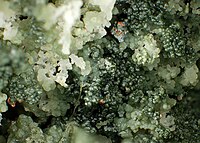Ovotransferrin aka conalbumin
Ovotransferrin (conalbumin) is a glycoprotein of egg white albumen. Egg white albumen is composed of multiple proteins, of which ovotransferrin is the most heat reliable. It has a molecular weight of 76,000 daltons and contains about 700 amino acids. Ovotransferrin makes up approximately 13
Lactalbumin aka whey protein
Lactalbumin, also known as “whey protein“, is the albumin contained in milk and obtained from whey. Lactalbumin is found in the milk of many mammals. There are alpha and beta lactalbumins; both are contained in milk. Targeted small scientific studies su
Subtilisin
Subtilisin is a protease (a protein-digesting enzyme) initially obtained from Bacillus subtilis. Subtilisins belong to subtilases, a group of serine proteases that – like all serine proteases – initiate the nucleophilic attack on the peptide (amide) bond through a serine residue a
Proprotein convertases (PPCs) are a family of proteins that activate other proteins
Many proteins are inactive when they are first synthesized, because they contain chains of amino acids that block their activity. Proprotein convertases remove those chains and activate the protein. The prototypical proprotein convertase is FURIN. Proprotein convertases have medical significance,
Brain-derived neurotrophic factor (BDNF) aka abrineurin
Brain-derived neurotrophic factor (BDNF), or abrineurin, is a protein that, in humans, is encoded by the BDNF gene. BDNF is a member of the neurotrophin family of growth factors, which are related to the canonical nerve growth factor (NGF), a family which also includes NT-3 and NT-4/N
Neurotrophin-3 and Neurotrophin-4
Neurotrophin-4 (NT-4), also known as neurotrophin-5 (NT-5), is a protein that in humans is encoded by the NTF4 gene. It is a neurotrophic factor that signals predominantly through the TrkB receptor tyrosine kinase. NT-4 was first discovered and isolated from xenopus and viper in the ye
Sortilin
Sortilin (SORT1) is a protein that in humans is encoded by the SORT1 gene on chromosome 1. This protein is a type I membrane glycoprotein in the vacuolar protein sorting 10 protein (Vps10p) family of sorting receptors. While it is ubiquitously expressed in many tissues, sortilin is most
A growth factor receptor is a receptor that binds to a growth factor
Growth factor receptors are the first stop in cells where the signaling cascade for cell differentiation and proliferation begins. Growth factors, which are ligands that bind to the receptor are the initial step to activating the growth factor receptors and tells the cell to grow and/or divide. Th
Nerve Growth Factor
Nerve growth factor (NGF) is a neurotrophic factor and neuropeptide primarily involved in the regulation of growth, maintenance, proliferation, and survival of certain target neurons. It is perhaps the prototypical growth factor, in that it was one of the first to
The Two-Faced Troublemaker: Bacillus cereus, the Jekyll and Hyde of Bacteria
Bacillus cereus is the bacterial world’s very own shape-shifting supervillain! This microscopic menace is the master of disguise, equally at home in your garden soil as it is crashing your dinner party. Picture, if you will, a rod-shaped rascal with a penchant for party-crashing. B. cereus is
Flacherie (and a ridiculous history of Bt development…roundabout)
History of Bt Development as told in New Innovative Pesticides: An Evaluation of Incentives and Disincentives for Commercial Development by Industry, Stanford Research Institute (Final Report dated September 1977, Prepared for Economic Analysis Branch Criteria and Evaluation Division Office of Pesti
Bacillus thuringiensis: the James Bond of biological pest control
In the microscopic world of bacteria, Bacillus thuringiensis (Bt), a gram-positive, soil-dwelling microbe is the go-to secret agent for farmers and gardeners worldwide, thanks to its uncanny ability to produce crystal-clear killers. From Silkworms to Superbugs Our story begins in 1902 when Japanese
Laterite
Laterite is a soil type rich in iron and aluminium and is commonly considered to have formed in hot and wet tropical areas. Nearly all laterites are of rusty-red coloration, because of high iron oxide content. They develop by intensive and prolonged weathering of the underlying parent rock
Saprolite
Saprolite is a chemically weathered rock. Saprolites form in the lower zones of soil profiles and represent deep weathering of the bedrock surface. In most outcrops, its color comes from ferric compounds. Deeply weathered profiles are widespread on t
Detritus (geology)
Detritus is particles of rock derived from pre-existing rock through weathering and erosion. A fragment of detritus is called a clast. Detrital particles can consist of lithic fragments (particles of recognisable rock), or of monomineralic fragments (mineral grains). These particles are of







